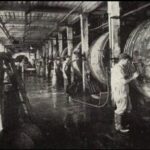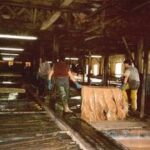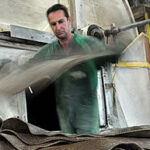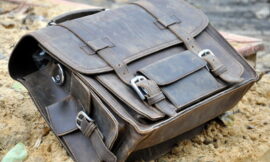
Tanning is one of the many processing steps (but undoubtedly the most crucial step) involved in converting raw hides or skins into finished leather that is more durable, flexible and less susceptible to decomposition. Leather tanning is an ancient technology, but until today has remained a craft industry worldwide.
Leather tanning is a process that permanently alters the protein structure of skin. The making of “rawhide” does not require the use of tannins. Rawhide is made by removing the flesh and fat and then the hair by use of an aqueous solution (this process is often called “liming” when using lime and water or “bucking” when using wood ash (lye) and water), then scraping over a beam with a somewhat dull knife, then drying. The two aforementioned solutions for removing the hair also act to clean the fiber network of the skin and allow penetration and action of the tanning agent, so that all the steps, except drying, in the preparation of rawhide are often preludes to the more complex process of tanning and production of leather. Before tanning, the skins are unhaired, degreased, desalted and soaked in water over a period from 6 hours to 2 days.1
To speed up this process, old tanning agents, such as alum and salts were gradually replaced by newer chemicals. Chromium tanning was invented in the 1800’s that enabled a shorter time in the entire process. In addition, instead of using clay lined pits, the tanners began using rotating drums. The drums allowed the hide to be subjected to the actual ‘tanning’ step of the process more thoroughly and quickly. 2
Leather tanning is without a doubt one of the oldest human activities. In the beginning, skins obtained from hunting and livestock breeding could be used for clothing or tents, but they became stiff at low temperatures and rotted with heat. It was probably then that attempts were made to render them more flexible and stronger by rubbing in animal fats; the first rudimentary tanning process is mentioned in Assyrian texts and in Homers Iliad.3
The name tannin applies to coarsely powdered bark that is obtained mostly from oak and hemlock trees, although all barks contain more or less tannin, and in some countries the extract of others is used. To tan a skin is to saturate it with tannin in such a manner as to promote the slow combination of this principle with the gelatine, albumen, and fibrine contained in the former.4
Tanning is a general term used for the process of converting animal skins to finished leather. Animal hides and skins absorb tannins to keep them from decaying and to keep them pliable. Technically, the term “tanning” refers to the process by which collagen fibers in a hide react with a chemical agent (tannin, alum or other chemicals), but the term leather tanning also commonly refers to the entire leather making process.5 The most common tanning agents used in the U. S. are trivalent chromium and vegetable tannins extracted from specific tree barks.6
Nowadays the best tanning factories are in German, US, Italy. Many of them have branches in Asia, Europe, USA and South America. Most Asian countries do not have the technology/machines to carry out the tanning process. They also do not have big cows required to produce large leather pieces for briefcases. Big cows normally come from Brazil, Texas and Europe. After the cow is slaughtered in a factory such as in Texas, the cowskin with furs and blood is then sent to South Asia to remove furs and blood, a process that can cause heavy pollution to the locals; then the clean half product will be sent to other countries for final processing, such as tanning and conditioning. A leather factory in Shangdong, China each day exports about 40,000 square feet to United States for the purpose of making auto seat leather covers. Mexico also produces some leather. The leather from Mexico is normally thick and stiff. One well-known leather company based in Texas has tanning factory on the Mexican border. It also produces quite heavy leather bags there.
Reference———–
- http://en.wikipedia.org/wiki/Tanning
- http://www.squidoo.com/cows-to-jackets
- http://www.leatherresource.com/history.html
- http://www.publicbookshelf.com/public_html/The_Household_Cyclopedia_of_General_Information/historyof_cff.htm
- http://serc.carleton.edu/woburn/issues/tanning.html
- http://www.epa.gov/ttnchie1/ap42/ch09/final/c9s15.pdf#search=%22leather%20tanning%22






